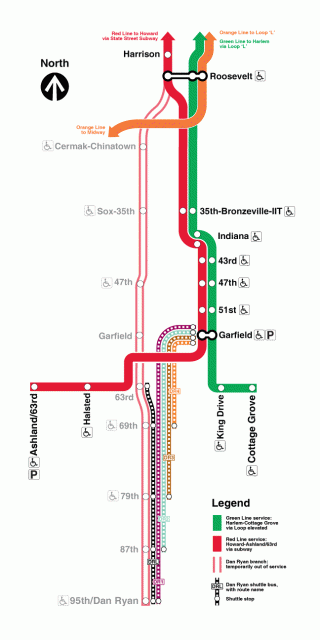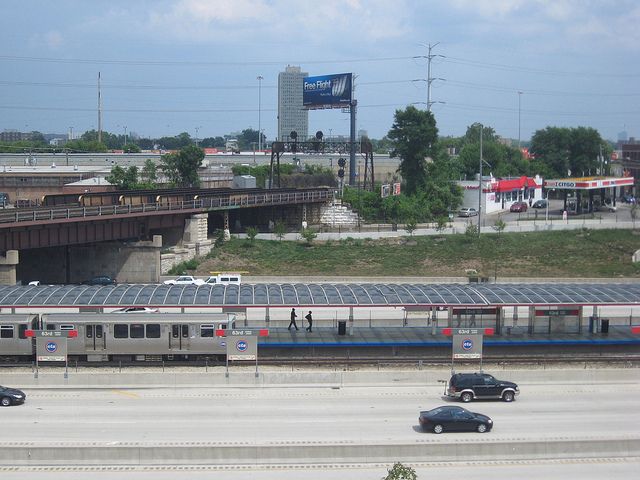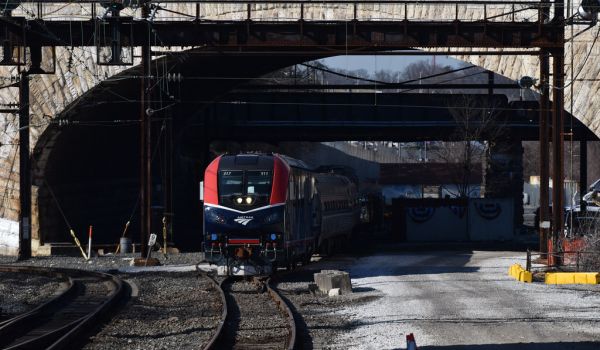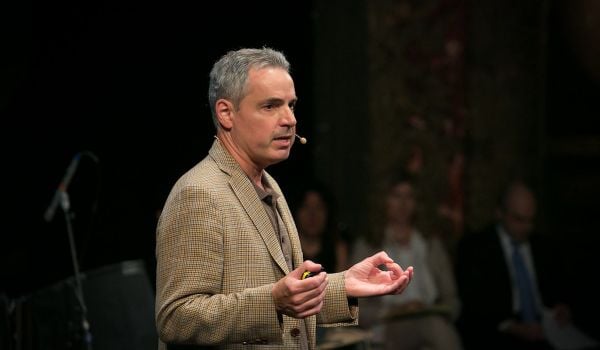In less than a year’s time, the Chicago Transit Authority will eliminate service on portions of the Red Line, a rail line that runs through the city’s south side, affecting roughly 80,000 daily journeys for a period of five months. The effort is designed to allow for the quick renovation of this rapid transit segment, replacing about 10 miles of degraded track with desperately needed new infrastructure.
It’s a risky move, likely to enflame tensions in an area of the city that has suffered decades of economic difficulties. But if the CTA pulls the project off successfully, Chicago may be setting a precedent for other cities to follow.
The southern portion of the Red Line is is poor condition, no question about it. Built in 1969, the route — known as the Dan Ryan Branch as it runs in the median of the Dan Ryan Expressway (I-90 and I-94) — is aging rapidly. At the moment, service is incredibly sluggish because the CTA has mandated “slow zones” that restrict trains to speeds far below their capacity, to ensure safety; on the southbound service from Roosevelt to 95th Street, for example, 2.6 miles of service is limited to just 15 mph. As a result, people are literally wasting their lives on their journeys home from work.
The CTA could reconstruct the line, replacing ties, tracks, third rail, ballast and drainage systems, by shutting it down on weekends. But that would take four years.
Instead, the agency has determined that a five-month shutdown, costing about $425 million and funded by the city’s infrastructure initiative, will not only save about $75 million in project costs (thanks to efficiencies in project delivery), but will also provide much better service to daily commuters far more quickly. Journey times from 95th Street to Roosevelt Road are expected to be a full 10 minutes more rapid by the time work finishes. That makes sense: Reconstructing a major piece of infrastructure is simply easier when there aren’t vehicles running through it, interrupting work. And customers will surely appreciate the much better transit they experience, even with a few months of annoyance, rather than many more years of bad service.
The last time the CTA attempted a similar move was in the mid-1990s, when it closed the Green Line for two years to reconstruct it completely. While that renovation produced the desired results in terms of infrastructure improvements, ridership on the line had trouble recovering. The simple fact was that the shutdown made transit inconvenient for people who had been used to riding the line. Only through a concerted effort to retain ridership through good service provision even in the absence of the Red Line can such problems be avoided.

Credit: Chicago Transit Authority
The CTA has developed a management plan designed to reroute passengers who currently use the Red Line onto other services in the South Side, as shown on the map to the right. This will be made easier by the fact that the Green Line is just a few blocks east of the Red Line between Roosevelt and 63rd Street, so most customers will likely just switch to that other service, which is linked to all the same crosstown bus routes as the Red Line. This will be made especially easy because Green Line trains using the Ashland branch of the service will be directed into the Red Line tunnel and north to Howard as “Red Line” trains, rather than around the Loop, as are all Green Line trains currently. This will provide direct service to the city’s North Side for people on the Green Line, which will surely be appreciated by many customers who now must transfer to get to that part of the city.
In addition, the CTA will operate reduced-priced express shuttles to and from closed Red Line stops from 63rd to 95th Streets to the Garfield station on the Green Line. Many may actually see faster service than they experience on slow trains today, even though they will have to transfer.
One possibility that CTA officials have not announced is encouraging current Red Line riders to use the Metra commuter rail trains on the Rock Island and Electric district lines, which also run parallel to the Red Line. If the CTA worked with Metra to institute common fare policies, reduced-cost transfers, and more frequent trains during the disrupted period, a large number of commuters who currently live near Metra stops but do not currently take advantage of the system because of its high prices and low frequencies could be better served.
The lack of connection between the CTA and Metra systems is one of the Chicago region’s biggest transportation limitations; experimenting with their integration during the Red Line shutdown could be particularly fruitful.
All of this raises questions about the future of transit reconstruction projects, both in Chicago and nationwide. There is plenty of need for transportation infrastructure renovations, but those must be performed on facilities that are in daily use by people who need to be able to get to and from work. Indeed, Chicago’s next big project will be the renovation of the north section of the Red Line, which is much older than this southern section and carries almost two times as many people daily, but which does not have the advantage of another parallel rapid transit line just a few blocks away.
Will that branch also need to be closed? The city’s success in rerouting travelers onto other services with the fewest amount of difficulties could test how much the people of Chicago are willing to take when it comes to the temporary closure of their means of transportation.

Yonah Freemark is a senior research associate in the Metropolitan Housing and Communities Policy Center at the Urban Institute, where he is the research director of the Land Use Lab at Urban. His research focuses on the intersection of land use, affordable housing, transportation, and governance.
















